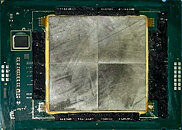- Joined
- Aug 19, 2017
- Messages
- 3,255 (1.13/day)
Thanks to the information coming from Yuuki_Ans, a person which has been leaking information about Intel's upcoming 4th generation Xeon Scalable processors codenamed Sapphire Rapids, we have the first die shots of the Sapphire Rapids processor and its delidded internals to look at. After performing the delidding process and sanding down the metal layers of the dies, the leaker has been able to take a few pictures of the dies present on the processor. As the Sapphire Rapids processor uses multi-chip modules (MCM) approach to building CPUs, the design is supposed to provide better yields for Intel and give the 10 nm dies better usability if defects happen.
In the die shots, we see that there are four dies side by side, with each die featuring 15 cores. That would amount to 60 cores present in the system, however, not all of the 60 cores are enabled. The top SKU is supposed to feature 56 cores, meaning that there would be at least four cores disabled across the configuration. This gives Intel flexibility to deliver plenty of processors, whatever the yields look like. The leaked CPU is an early engineering sample design with a low frequency of 1.3 GHz, which should improve in the final design. Notably, as Sapphire Rapids has SKUs that use in-package HBM2E memory, we don't know if the die configuration will look different from the one pictured down below.




View at TechPowerUp Main Site
In the die shots, we see that there are four dies side by side, with each die featuring 15 cores. That would amount to 60 cores present in the system, however, not all of the 60 cores are enabled. The top SKU is supposed to feature 56 cores, meaning that there would be at least four cores disabled across the configuration. This gives Intel flexibility to deliver plenty of processors, whatever the yields look like. The leaked CPU is an early engineering sample design with a low frequency of 1.3 GHz, which should improve in the final design. Notably, as Sapphire Rapids has SKUs that use in-package HBM2E memory, we don't know if the die configuration will look different from the one pictured down below.




View at TechPowerUp Main Site





